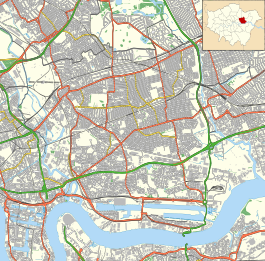
Back كانينغ تاون (محطة مترو أنفاق لندن) Arabic Canning Town (stanice metra v Londýně) Czech Canning Town (London Underground) German ایستگاه کنینگ تاون Persian Canning Townin asema Finnish Canning Town (métro de Londres) French 卡寧塘站 GAN Canning Town állomás Hungarian Stazione di Canning Town Italian Stazion de Canning Town LMO
| Canning Town | |
|---|---|
 Jubilee line platforms, with DLR platforms above | |
| Location | Canning Town |
| Local authority | London Borough of Newham |
| Managed by | London Underground London Buses |
| Owner | Transport for London |
| Number of platforms | 6 |
| Accessible | Yes[1] |
| Fare zone | 2 and 3 |
| London Underground annual entry and exit | |
| 2019 | |
| 2020 | |
| 2021 | |
| 2022 | |
| 2023 | |
| DLR annual boardings and alightings | |
| 2019 | |
| 2020 | |
| 2021 | |
| 2022 | included in Underground usage[10] |
| 2023 | included in Underground usage[11] |
| Key dates | |
| 14 June 1847 | First station opened as Barking Road |
| 1 July 1873 | Renamed Canning Town |
| 1888 | Relocated |
| 29 May 1994 | Second station closed |
| 29 October 1995 | Third station opened |
| 5 March 1998 | DLR platforms to Beckton opened |
| 14 May 1999 | Jubilee line opened |
| 2 December 2005 | DLR started to King George V |
| 9 December 2006 | North London service withdrawn |
| 31 August 2011 | New DLR platforms open on Stratford International branch[12] |
| Other information | |
| External links | |
| Coordinates | 51°30′50″N 0°00′30″E / 51.5140°N 0.0083°E |
Canning Town is an interchange station located in Canning Town, London for London Underground, Docklands Light Railway (DLR) and London Buses services.
It is designed as an intermodal metro and bus station, fully opening in 1999 as part of the Jubilee Line Extension - replacing the original station site north of the A13.[13]
On 11 November 2015, the Mayor of London announced that it would be rezoned to be on the boundary of Travelcard Zone 2 and Travelcard Zone 3.[14]
- ^ "Step free Tube Guide" (PDF). Transport for London. April 2021. Archived (PDF) from the original on 15 May 2021.
- ^ "Station Usage Data" (XLSX). Usage Statistics for London Stations, 2019. Transport for London. 23 September 2020. Archived from the original on 9 November 2020. Retrieved 9 November 2020.
- ^ "Station Usage Data" (XLSX). Usage Statistics for London Stations, 2020. Transport for London. 16 April 2021. Retrieved 1 January 2022.
- ^ "Station Usage Data" (XLSX). Usage Statistics for London Stations, 2021. Transport for London. 12 July 2022. Retrieved 7 September 2022.
- ^ "Station Usage Data" (XLSX). Usage Statistics for London Stations, 2022. Transport for London. 4 October 2023. Retrieved 10 October 2023.
- ^ "Station Usage Data" (XLSX). Usage Statistics for London Stations, 2023. Transport for London. 8 August 2024. Retrieved 16 September 2024.
- ^ "Station Usage Data" (XLSX). Usage Statistics for London Stations, 2019. Transport for London. 23 September 2020. Retrieved 9 January 2022.
- ^ "Station Usage Data" (XLSX). Usage Statistics for London Stations, 2020. Transport for London. 16 April 2021. Retrieved 9 January 2022.
- ^ "Station Usage Data" (XLSX). Usage Statistics for London Stations, 2021. Transport for London. 12 July 2022. Retrieved 7 September 2022.
- ^ "Station Usage Data" (XLSX). Usage Statistics for London Stations, 2022. Transport for London. 4 October 2023. Retrieved 20 October 2023.
- ^ "Station Usage Data" (XLSX). Usage Statistics for London Stations, 2023. Transport for London. 8 August 2024. Retrieved 16 September 2024.
- ^ Cite error: The named reference
tflsiwas invoked but never defined (see the help page). - ^ Powell, Ken, 1947- (2000). The Jubilee Line extension. London: Laurence King. ISBN 1-85669-184-5. OCLC 42444848.
{{cite book}}: CS1 maint: multiple names: authors list (link) CS1 maint: numeric names: authors list (link) - ^ "Mayor announces real terms fares freeze". London City Hall. 11 November 2015. Retrieved 28 May 2020.
